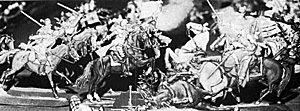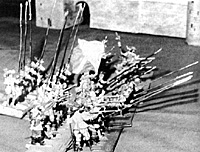 LE KRIEGSPIEL was published in France around 1963 by
Pierre Foure, Jean Belaubre, and others. The published
version was essentially a smooth bore musket period game.
However, other variants for ancient, medieval, pike and shot,
1870 and later periods exist, including some widely used (in
France) American Civil War rules. Pat Condray published a
translation around 1965 and a revised version in 1969. Most
were sold through THE ARMCHAIR GENERAL (Pat's
magazine of the late 60's, early 70's - Ed.).
LE KRIEGSPIEL was published in France around 1963 by
Pierre Foure, Jean Belaubre, and others. The published
version was essentially a smooth bore musket period game.
However, other variants for ancient, medieval, pike and shot,
1870 and later periods exist, including some widely used (in
France) American Civil War rules. Pat Condray published a
translation around 1965 and a revised version in 1969. Most
were sold through THE ARMCHAIR GENERAL (Pat's
magazine of the late 60's, early 70's - Ed.).
The rules were originally designed for use on a board marked in polygons, but have been herein adopted for use on an unmarked surface. The movement and melee powers are explained below, however, a few general notes may clarify the method of play.
Movement is nominally simultaneous. However, each player completes movement on one half (right or left) of his side of the board before he can start moving troops on the other half. I.e. both players are simultaneously moving troops on his right (or left) side.
Choice of sides on which to move first is conferred by rolling 1 die per side-high score wins. Prior to choice of sides being determined, forced retreats, and designated retreats are taken. Then those units which have won melees may exercise the option to occupy conquered ground or pursue beaten enemy units. Also, those units forced to rally (escaping pursuit, or cavalry rallying after pursuit or melee) may be placed where they are to rally.
 After all movement is complete, all units in range, beginning with artillery, may fire. One die is rolled per base (sometimes more for artillery firing cannister) to determine hits. Casualties are by individual figure. Casualties are then removed (or marked) and only the survivors count in melees. Normally only front ranks may fire. Exceptions are troops firing up at targets on hills or stepped on the front slope firing at troops on the flat. Units in defended buildings are assumed to pass loaded muskets to those at windows (or take turns at that post) so that all may fire.
After all movement is complete, all units in range, beginning with artillery, may fire. One die is rolled per base (sometimes more for artillery firing cannister) to determine hits. Casualties are by individual figure. Casualties are then removed (or marked) and only the survivors count in melees. Normally only front ranks may fire. Exceptions are troops firing up at targets on hills or stepped on the front slope firing at troops on the flat. Units in defended buildings are assumed to pass loaded muskets to those at windows (or take turns at that post) so that all may fire.
TROOP ORGANIZATION - 1680
MUSKETEERS: 4 bases of 6 musketeers (in 2 ranks)
MIXED INF: 1 base of 9 pikemen (in 3 ranks) and 2
ED MF: musketeer bases (usually 1 on each side)
PIKES: No all pike units
LT. CAVALRY: 2 bases of 3 figures (in one rank)
MED. CAVALRY: 2 bases of 3 figures (in one rank)
HVY. CAVALRY: 2 bases of 6 figures (in two ranks)
ARTILLERY: 1 gun with 3 to 4 crewmen per base
SWORD & BUCKLER: as musketeers
| Unit | walk | trot | chg/gal | Retreat 1st/2nd | rd. col | rte col |
|---|---|---|---|---|---|---|
| Polish Hussar | 4" | 8" | 12" | 4/8" | 12" | - |
| Other heavy | 4" | 8" | 12" | 4/8" | 12" | - |
| Spahis | 4" | 8" | 12" | 4/8" | 12" | - |
| Light horse | 4" | 8" | 16" | 4/8" | 16" | - |
| Staff | 4" | 8" | 24" | - | ||
| Mixed infantry | 4" | - | 6" | 4/8" | 6" | 5" |
| Other infantry | 4" | - | 8" | 4/8" | 6" | 5" |
| Square | 2" | - | ||||
| Light gun | 3" | - | 6" | 5" | ||
| Medium gun | 2" | - | 5" | 4" | ||
| Heavy gun | N/A | - | 4" | 3" | ||
MELEE
Melees are resolved by the combat values of troops adjusted by tactical factors (flank, rear, disorder, etc.) and various uses of ordinary dice. There are also various provisions intended to minimize the overpowering influence of chance. Normally a full tactical unit of up to 4 single bases of infantry or 2 of cavalry counts in a melee. However, only the base adjoining that contacted (within 1 ") add up to 4 deep infantry or 2 deep cavalry counts. Thus a 4 base single line or infantry, struck on one end, engages only 2 bases. However, the whole unit breaks if defeated. In a pike and shot unit of 3 bases, with pikes 3 deep flanked by musketeers 2 deep, the pikes will support either musket wing engaged. Regardless of formation, a tactical unit struck in flank or rear will suffer deductions against all of its bases.
Melee is resolved as follows: Combat values (adjusted by tactical factors) are multiplied by a score of 3 dice per unit. High score wins. One casualty is suffered per victorious unit. Two dice are rolled, and the difference applied to a combat results table.
If the victor numbered fewer combat points, or in any case if the loser isn't routed, 1 casualty is suffered per defeated tactical unit by the victor.
| MELEE POWERS | ||||
|---|---|---|---|---|
| Unit | Figures base | Basic points | Impetus points | Square |
| Polish Hussar | 6 | 4 | 3 | N/A |
| Heavy | 6 | 4 | 1 | N/A |
| Spahis | 6 | 2 | 2 | N/A |
| Light | 3 | .5 | 1 | N/A |
| Pike | 9 | 8 | 1 | 6 |
| Musket Spear Bay | 6 | 2/3 | 1 | 2 |
| Musket/Sword | 6 | 3/2 | 1 | 1 |
| Sword/Buckler | 6 | 3/2 | 1 | 1 |
No impetus for troops firing, or when attacking pikes, spears, or bayonet squares with cavalry. The first number is value against infantry, the second against cavalry Lowest number applies against combined arms. If one of the front bases of a sword and buckler unit rolls a 5 orb entering a melee with infantry, it adds 2 points.
Cavalry fights with minimum frontage of 2 bases.
6 rolled by a defending unit stops a charge at point blank range
6 rolled by an attacking unit throws the defender into disorder (-1 pt per base)
unit hit in rear loses 2 melee points per base, In flank, -1.
Houses add 3-5 points/base or agreement. All troops attacking houses count 1 point per infantry or dismounted dragoon base.
The same applies to defense. Pikes are very clumsy indoors.
Cavalry on horses don't attack buildings.
Bridges add 2 points per unit defending it (not per base), hedges add 3 per unit, walls add 6 per unit a redoubt adds 24 If a general is present with the attackers add one die.
| COMBAT RESULTS TABLE | |||
|---|---|---|---|
| Dice Difference | Infantry | Cavalry | Artillery |
| 0 | 1 casualty | 1 casualty | Gun wrecked gunners escape |
| 1 | 2 | 1 | Guns captured |
| 2 | 3 | 1 | Guns captured |
| 3 | 4 | 2 | Guns captured |
| 4 | 5 | 2 | Guns captured |
| 5 | 6 | 2 | Guns captured |
Light horse and unsupported muskets (other than certain squares) are routed by differences of more than 0. Those catagories (mixed infantry and squares of bayonets/s pears) hold on 0-1, retreat in order on 2-3, retreat shaken on 4, rout on 5, Heavy european cavalry hold on 0, retreat in order on 1 or 2, disordered on 3, rout on 4 or 5,
| WEAPON RANGES AND EFFECTS | |||
|---|---|---|---|
| Hit with | 4-5-6 | 5-6 | 6 |
| Heavy Gun | 16" (3 dice) | 24" (2 dice) | 40" (1 die) |
| Medium Gun | 12" (2 dice) | 16" (2 dice) | 32" (1 die) |
| Light Gun | 8" (2 dice) | 12" (2 dice) | 24" (1 die) |
| Supported Musket | 8" | 12" | - |
| Musket | - | 8" | 12" |
| MTD carbine/Archer | - | 4" | 8" |
| Pistol | - | - | 4" |
Bases having lost half their figures cannot fire but melee normally. When a whole unit has lost half its figures it withdraws from the field. If a formed unit has to retreat though another unit, both units are disordered.
ERRATA LE KRIEGSPIEL-VOL III, NO 3
 Movement: Cavalry gallop (and all fire) is in a line no more than 30
degrees off straight ahead. Trot may make two 30 degree changes or
permit filing off 8" to left or right rear. The 4" retreat move is
straight back. On second or later retreat moves use gallop speeds.
Movement: Cavalry gallop (and all fire) is in a line no more than 30
degrees off straight ahead. Trot may make two 30 degree changes or
permit filing off 8" to left or right rear. The 4" retreat move is
straight back. On second or later retreat moves use gallop speeds.
Melee: Double the values shown for squares. Disorder reduces defenders value by 1 pt per base. For all deductions as well as constituting a base forfire action, counttwo light horse bases as a base.
Skirmishers/foragers do not fight formed troops. Cavalry will evade infantry otherwise the open order troops contacted lose 1 figure per enemy unit and rout.
Fire Effect: Refence to defending fire stopping charges, or cavalry or infantry throwing a defender into disorder relates to firing immediately before melee. Pistol fire entering melee will hit with a 4-5-6 on the die, but only a 6 causes disorder. Thus a cavalry unit may forfeit impetus, fire its two front bases and have two chances to disorder the enemy with fire.
Back to Table of Contents -- Courier Vol. III #3
To Courier List of Issues
To MagWeb Master Magazine List
© Copyright 1981 by The Courier Publishing Company.
This article appears in MagWeb (Magazine Web) on the Internet World Wide Web.
Other military history articles and gaming articles are available at http://www.magweb.com